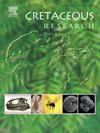Pneumatic structures of sauropod cervical vertebrae from the Lower Cretaceous Sao Khua Formation of northeastern Thailand
IF 1.7
3区 地球科学
Q1 GEOLOGY
引用次数: 0
Abstract
Internal structures of sauropod vertebrae are hollowed out by pneumatic diverticular systems similar to extant birds. Their vertebral columns contain extensive air sac systems that are highly prominent in the cervical regions. Here we analyze the pneumatic structures in the cervical vertebrae of two sauropod taxa: Phuwiangosaurus sirindhornae and a diplodocoid sauropod, from the Lower Cretaceous Sao Khua Formation of northeastern Thailand, using a CT-scan technique. The internal pneumatic structures of P. sirindhornae mainly consisted of camerae within the centrum and systems of camellae in the articulation regions, representing a semicamellate pattern. The diplodocoid sauropod exhibited a camerate pattern with its centrum filled with only pneumatic camerae. The semicamallate pattern of Phuwiangosaurus sirindhornae is similar to that of Brachiosaurus sp. and Giraffatitan brancai, differing from previous interpretations that suggested a close relationship to somphospondyls. Due to the more primitive internal structures of Phuwiangosaurussirindhornae, we instead propose that Phuwiangosaurus is a non-somphospondyl titanosauriform more closely related to brachiosaurids. In the Sao Khua diplodocoid sauropod, the vertebral pneumatization was much higher than in dicraeosaurids but less intense than in most neosauropods. The presence of a semicamellate pattern in Phuwiangosaurus extends the temporal range of such a condition to the Early Cretaceous, while the camerate pattern of the Sao Khua diplodocoid suggests that Cretaceous dicraeosaurids likely had a varying degree of pneumaticity, which might have evolved independently in their lineages.
泰国东北部下白垩世Sao Khua组蜥脚类动物颈椎的气动结构
蜥脚类动物椎骨的内部结构被类似于现存鸟类的气动憩室系统掏空。他们的脊柱包含广泛的气囊系统,在颈椎区域非常突出。本文利用ct扫描技术对泰国东北部下白垩世圣花组的Phuwiangosaurus sirindhornae和梁龙科蜥脚类恐龙的颈椎气动结构进行了分析。柽柳的内部气动结构主要由中心内的照相机和关节区的山茶花系统组成,呈半束状结构。梁龙科蜥脚类动物表现出照相机模式,其中央仅充满气动照相机。Phuwiangosaurus sirindhornae的半掌形模式与腕龙(Brachiosaurus sp.)和长颈鹿(Giraffatitan branchai)的相似,不同于以往认为与somphospondyls有密切关系的解释。由于Phuwiangosaurussirindhornae的内部结构更原始,我们认为Phuwiangosaurus是一种与腕龙类关系更密切的非somphospondyl泰坦龙。在圣华梁龙科蜥脚类动物中,椎体气化程度远高于二龙类动物,但低于大多数新蜥脚类动物。Phuwiangosaurus身上的半袖口模式将这种情况的时间范围扩展到了早白垩纪,而Sao Khua梁龙科的袖口模式表明,白垩纪的二龙类可能具有不同程度的气性,这可能是在它们的谱系中独立进化的。
本文章由计算机程序翻译,如有差异,请以英文原文为准。
求助全文
约1分钟内获得全文
求助全文
来源期刊

Cretaceous Research
地学-地质学
CiteScore
4.10
自引率
19.00%
发文量
235
审稿时长
12 weeks
期刊介绍:
Cretaceous Research provides a forum for the rapid publication of research on all aspects of the Cretaceous Period, including its boundaries with the Jurassic and Palaeogene. Authoritative papers reporting detailed investigations of Cretaceous stratigraphy and palaeontology, studies of regional geology, and reviews of recently published books are complemented by short communications of significant new findings.
Papers submitted to Cretaceous Research should place the research in a broad context, with emphasis placed towards our better understanding of the Cretaceous, that are therefore of interest to the diverse, international readership of the journal. Full length papers that focus solely on a local theme or area will not be accepted for publication; authors of short communications are encouraged to discuss how their findings are of relevance to the Cretaceous on a broad scale.
Research Areas include:
• Regional geology
• Stratigraphy and palaeontology
• Palaeobiology
• Palaeobiogeography
• Palaeoceanography
• Palaeoclimatology
• Evolutionary Palaeoecology
• Geochronology
• Global events.
 求助内容:
求助内容: 应助结果提醒方式:
应助结果提醒方式:


